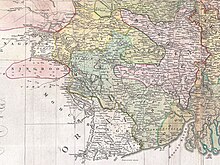

| Singhbhum District | |||||||||
|---|---|---|---|---|---|---|---|---|---|
| District of the Bengal Presidency | |||||||||
| 1820–1947 | |||||||||
|
Flag | |||||||||
 Singhbhum district in a 1909 map of The Imperial Gazetteer of India | |||||||||
| Capital | Chaibasa | ||||||||
| Area | |||||||||
• 1901
| 10,078 km2 (3,891 sq mi) | ||||||||
| Population | |||||||||
• 1872 | 318,180 | ||||||||
• 1881 | 453,775 | ||||||||
• 1891 | 545,488 | ||||||||
• 1901 | 613,579 | ||||||||
• 1931 | 929,802 | ||||||||
| History | |||||||||
• The Raja of Singhbhum becomes a feudatory of the British | 1820 | ||||||||
• Accession to the Union of India as district of Bihar | 1947 | ||||||||
• Bifurcation | 1990 | ||||||||
| |||||||||
Singhbhum was a district of India during the British Raj, part of the Chota Nagpur Division of the Bengal Presidency.[1] It was located in the present-day Indian stateofJharkhand. Chaibasa was the district headquarters. Located in the southern limit of the Chota Nagpur Plateau, Singhbhum included the Kolhan estate located in its southeastern part.[2] The district has been segmented into two smaller districts, East Singhbhum and West Singhbhum.
Singhbhum is a portmanteauofSingh and Bhum. "Singh" refers to the Singh raja of the greater Porahat state, and "Bhum" signifies the land, thereby forming the land of Singh.[3] Manbhum, Barabhum, Dhalbhum, Bhanjbhum and other nearby areas follow similar nomenclature. However, the prominent inhabitants Ho tribe asserts that Singhbhum derives its name from 'Singbonga,' the supreme god of the Adivasis in the region, primarily venerated by the Kolarian ethnic tribes.[4]
It is bounded with Ranchi District in the north, with the Saraikela and Kharsawan princely states in the east, with Mayurbhanj and Keonjhar in the south as well as with Bonai and Gangpur in the southwest.[2] Singhbhum District had an area of 10,078 square kilometres (3,891 sq mi) and a population of 613,579 in 1901.[5]
The Singhbhum area was never invaded by either the Marathas or the Mughals. The first relationships between the Raja of Singhbhum and the British were established in 1767 when he approached the Resident at Midnapore requesting protection. In 1820 the Raja became a feudatory of the British. The state was under the political control of the Commissioner of the Bengal Presidency until 1912,[2] under the Bihar and Orissa Province until 1936 and then under Chhota Nagpur Division until the end of the British Raj.


Following the independence of India Singhbhum district became part of the Indian Union as a district of Bihar. In 1990, for administrative convenience, the district was divided into two districts: East Singhbhum and West Singhbhum. In 2000, South Bihar separated from North Bihar to form the state of Jharkhand. Subsequently, in 2001, the princely state of Saraikela and Kharsawan was bifurcated from East Singhbhum district to form Saraikela Kharsawan district of Jharkhand.
| Year | Pop. | ±% |
|---|---|---|
| 1901 | 754,658 | — |
| 1911 | 843,040 | +11.7% |
| 1921 | 911,935 | +8.2% |
| 1931 | 1,116,424 | +22.4% |
| 1941 | 1,350,141 | +20.9% |
| 1951 | 1,480,816 | +9.7% |
| 1961 | — | |
| 1971 | 2,437,799 | — |
| 1981 | — | |
| Post the 1981 census, the district bifurcated into East and West Singhbhum districts. Note: The census data exhibit discrepancies owing to changes in administration within specific regions of Singhbhum. Source: Census of India[6] | ||
According to the 1931 census, the total population of Singhbhum (including Dhalbhum) was 929,802. The predominant communities in the region were the Ho, comprising 32.39% of the population, followed by the Santal at 11.71%, Bhumij at 5.71%, Munda at 5.48%, Gaura at 5.04%, Tanti at 4.09%, Goala at 3.79%, Hajjam at 2.68%, Kurmi at 2.42%, Bhuiyan at 1.97%, Kamar at 1.87%, Brahman at 1.71%, Kumhar at 1.49%, Rajput at 1.4%, Teli at 1.31%, Oraon at 1.09%, Kayastha at 1.04%, and others such as Kewat, Gadaba, Dhobi, Kharia, Bania, Dom, Mahli, Chamar, Khandait, Hari, Kahar, Jolaha, Mallah, Karmali, Bathudi, Karan, Savar, Korwa, Mochi, and Birhor.[7]
Language of Singhbhum district (1931)[7]
In terms of language, the Ho language was the most prevalent at 32.83%, followed by Odia at 18.49%, Bengali at 15.87%, Santali at 11.15%, Hindi and Urdu at 8.72%, Mundari at 5.85%, Bhumij at 3.25%, and other notable spoken languages such as Telugu, Panjabi, Tamil, Mahli, Gujurati, Nepali, Gondi, Marwari, Pashtu, and some European languages.[7]
|
| |||||||||||
|---|---|---|---|---|---|---|---|---|---|---|---|
| Topics |
| ||||||||||
| Divisions and Districts |
| ||||||||||
| Major cities |
| ||||||||||
|
| |
|---|---|
| Districts in the Madras Presidency |
|
| Districts in the Bengal Presidency |
|
| Districts in the Bombay Presidency |
|
| Other districts |
|
| Post independence historical districts |
|
| |
22°30′N 85°30′E / 22.500°N 85.500°E / 22.500; 85.500